

Kobe Maritime Museum is a museum in Kobe, Japan focusing on the history of Japanese shipping and Kobe harbor.
One of the exhibits is the Yamato 1 .


Kobe Maritime Museum is a museum in Kobe, Japan focusing on the history of Japanese shipping and Kobe harbor.
One of the exhibits is the Yamato 1 .
34°40′58″N135°11′18″E / 34.68278°N 135.18833°E

Osaka Bay is a bay in western Japan. As an eastern part of the Seto Inland Sea, it is separated from the Pacific Ocean by the Kii Channel and from the neighbor western part of the Inland Sea by the Akashi Strait. Its western shore is formed by Awaji Island, and its northern and eastern shores are part of the Kansai metropolitan area.

Port Island is an artificial island in Chuo-ku, Kobe, Japan. It was constructed between 1966-1980 and 1987-2009 at Port of Kobe, and officially opened with an exposition called "Portopia '81." It now houses a heliport, numerous hotels, a large convention center, the UCC Coffee Museum, Japan's third IKEA store, and several parks.
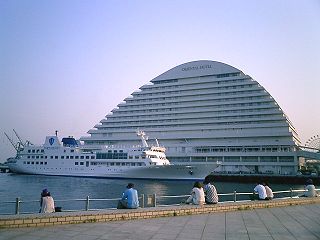
Kobe Meriken Park Oriental Hotel is a hotel located close to Meriken Park, in Kobe, Japan. It was opened in June, 1995, only 6 months after the Great Hanshin earthquake destroyed much of the city. It is in the Kobe waterfront area called Harborland, and is often featured in pictures of Kobe, together with Kobe Port Tower. It was designed by Takenaka Corporation to resemble a luxury liner. In 2003. it was owned by The Goldman Sachs Group. On February 15, 2006, Japan Hotel REIT Investment Corporation acquired the property for 11.4 billion yen.

Yamato-1 is a ship built in the early 1990s by Mitsubishi Heavy Industries, Ltd. at Wadasaki-cho Hyogo-ku, Kobe. It uses magnetohydrodynamic drives (MHDDs) driven by liquid helium-cooled superconductors and can travel at 15 km/h.

Higashinada is one of 9 wards of Kobe, Japan. It has an area of 30.36 km², and a population of 212,111 (2012). South of the Hanshin Main Line, it is also home to some notable sake brewing areas, including Uozaki and Mikage.
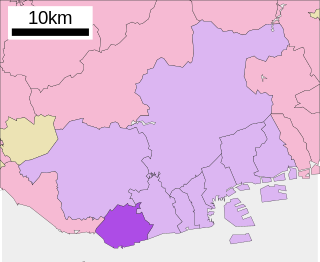
Tarumi is one of nine wards of Kobe, Japan. It has an area of 26.89 km², and a population of 219,958 (2008).

Kita is one of 9 wards of Kobe, Japan. It has an area of 241.84 km², and a population of 226,402 (2008). Kita in Japanese means North. Kita-ku is the biggest ward in Kobe and occupies the northeastern part of the city. Arima Onsen is located in Kita-ku.
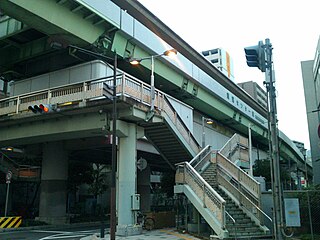
Bōeki Center Station is a railway station in Hyōgo Prefecture. It is located on the Port Liner in Chūō-ku, Kobe, Japan. Bōeki literally means trade in English. It is the only other station other than Sannomiya and Port Terminal to be on Honshu.
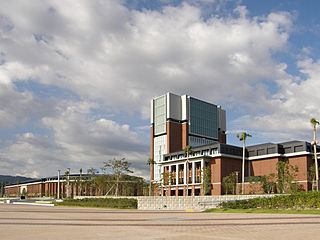
Kobe Gakuin University is a private, co-educational university located on the western edge of the city of Kobe, in Hyōgo Prefecture in Japan. It was founded in 1966 and overlooks the city of Akashi, the Akashi Straits and the Akashi Kaikyo Bridge - the longest suspension bridge in the world. The university has three campuses in Kobe. These are located near Akashi, near Nagata and on Port Island.

The Hyōgo Prefectural Museum of Art is a purpose built municipal art gallery in Nada-ku, Kobe, Hyōgo Prefecture, Japan. It was opened in 2002.

Harborland is a shopping district in Chuo-ku, Kobe, Japan. Kobe Port Tower is located there.

Nankin-machi is a neighborhood in Kobe, Japan located south of Motomachi station adjacent to the Daimaru Department Store and is a major tourist attraction. Considered as Kobe's Chinatown, the area has over a hundred Chinese restaurants, shops, and a Chinese temple dedicated to Lord Guan.

The Port of Kobe is a Japanese maritime port in Kobe, Hyōgo in the Keihanshin area, backgrounded by the Hanshin Industrial Region.

The Nunobiki Herb Garden is a herb garden located on Mount Rokkō above Kobe, Japan. It is open daily; an admission fee is charged.
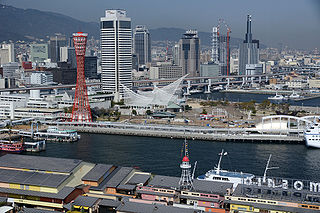
Meriken Park is a waterfront park located in the port city of Kobe, Hyōgo Prefecture, Japan. The park features the Kobe Port Tower, Kobe Maritime Museum, and a memorial to victims of the Great Hanshin earthquake. The name of the park comes from the word "American," which was commonly translated as "Meriken" during the Meiji era. Meriken Park is also the location of the Hotel Okura Kobe and Kobe Meriken Park Oriental Hotel.

Kobe Women's University is a private women's college in Kobe, Hyōgo, Japan. The predecessor of the school was founded in 1940, and it was chartered as a university in 1966.
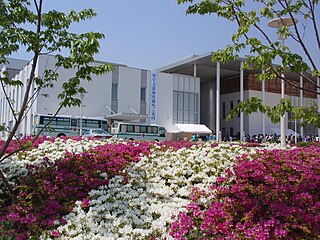
Kobe Shukugawa Gakuin University, colloquially abbreviated to {KSGU}, was a private non-sectarian and coeducational university located in Kobe, Japan. Established in 2007, it had been specialized in Tourism Studies. However, mainly due to the financial problems occurred in the management body, the university stopped admitting students from 2015 and almost all staffs and students moved to Kobe Yamate University after establishing a Tourism department there.
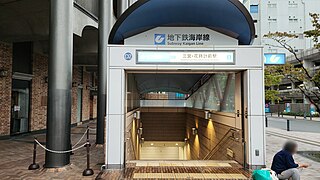
Sannomiya-Hanadokeimae Station is one of the termini on the Kobe Municipal Subway Kaigan Line in Chūō-ku, Kobe, Hyōgo Prefecture, Japan.

The Kobe City Museum opened in Kobe, Japan in 1982. It is one of Japan's many museums which are supported by a municipality.

The Kobe City Museum of Literature (神戸文学館) is dedicated to the literary scene in Kobe, Hyōgo Prefecture, Japan in the Meiji, Taishō, Shōwa, and Heisei periods. The museum opened in 2006 in the former Branch Memorial Chapel of Kwansei Gakuin University, a Meiji period building largely funded by John Kerr Branch, a scion and financier from Richmond, Virginia.